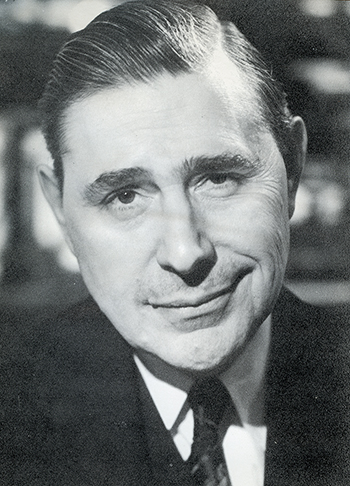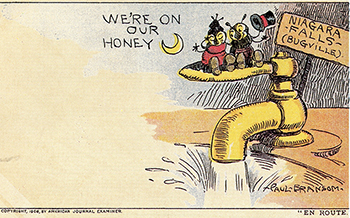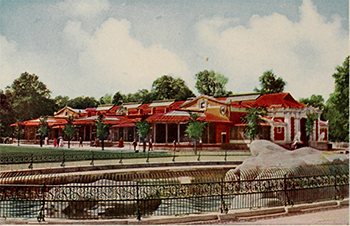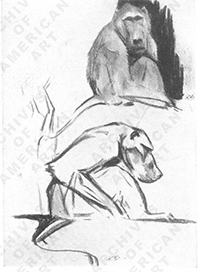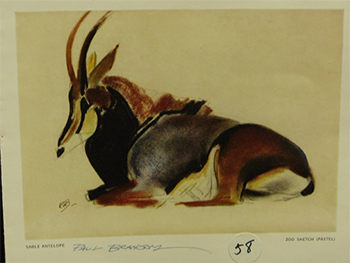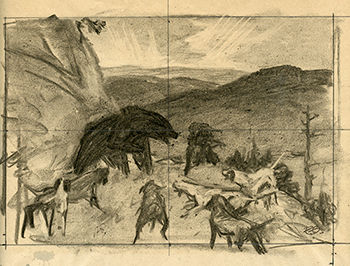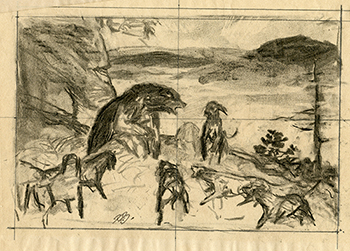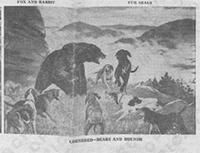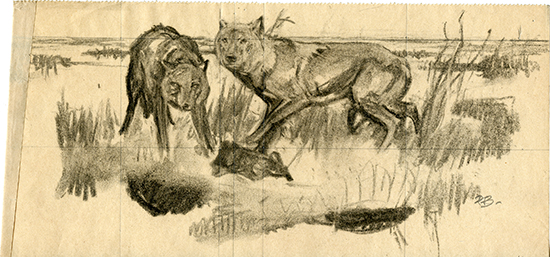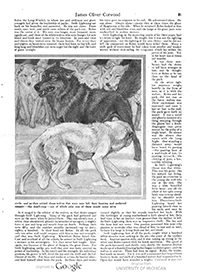
Home |Magazine Covers & Ads| Magazine Illustrations | Book Illustrations| Seagram's Calendars | Paul Bransom Remembered
In His Own Words
The bulk of the following account is found in a letter dated August 11, 1927 (nos. 36-40) to Lilian Cromelin of American Forests and Forest Life (nos. 5-9).This was used as the basis of an article on Bransom by Cromelin ("Artists of Outdoors," American Forests, March, 1929). The material in brackets come from an earlier account dated July 6, 1926 (no. 30-32). For a more extensive account see Paul Bransom as told to Helen Ireland Hays, All Unplanned: Memoirs of the Golden Age of Illustration, Johnstown, N.Y., 1983:
I earnestly beg your pardon for my neglect to comply with Mr. Gill’s kind request for some material regarding my work, and I must confess that the matter had entirely slipped my memory.
While I am making confessions, candor forces me to add that while I am highly appreciative of the honor of being asked to contribute to this series of articles, I cannot discover anything in my so far uneventful career which could have the interest for your readers which your letter implies.
I do aim to be an outstanding wild-life artist some day but at present I do not so consider myself as having attained that degree of achievement.
So far, my efforts have been devoted to the illustration of animal stories for various books and magazine publishers and I think perhaps I’ve been unusually fortunate in being associated with authors of great distinction and ability. Certainly such writers as Jack London, Charles G.D. Roberts, Kenneth Grahame, A. P. Terhune, Oliver Curwood, Emma Lindsay-Squier, Olaf Baker, H. R. Newell, Enos Mills, etc., --should afford sufficient inspiration for anyone.
If you can glean anything worth while from the following account of myself, here goes ---
Born in the old Means homestead in Brookland, D.C., and for the next fourteen years I was busy at regular boy stuff in Washington, where I went to public school.
[The inclination to draw manifested itself at a very early age and my choice of subject was invariably an animal of some sort. I cannot remember a time when the interest in animals was not an absorbing and a dominant one. I was one of those kids whose general conversation and argument –when I could find a kindred spirit—was whether a lion could beat a tiger and which could roar the loudest, etc. etc.]
On my first day in school, age 6 years, I happened to arrive at the school (the “Blair” school) building during a recess period and upon entering the first room at hand, which proved to be the eighth grade, and being all alone I son [sic] improved the opportunity to fill the big inviting blackboards with chalk drawings of animals. While I was thus pleasantly occupied the class and teacher returned to discover me and my impromptu art exhibition, whereupon the teacher asked me to explain my pictures, and I then gave my first and last chalk-talk. I have since been asked by too-discerning art-editions to explain drawings, but never again before such a crowd of delighted pupils as applauded my first appearance.
I wish that I could now conclude this account by saying that the teacher then gave me a drawing copy-book and I grew up to be a great artist! As a matter of fact, the teacher did give me a drawing book. However, as a school boy I did not manifest any extraordinary ability in drawing for I distinctly recall at least three boys in my class who showed considerably more facility in that direction. I believe only one of these is now an artist, and he, Mr. Benson Moore, is indeed a real artist. If I did not possess an unusual talent in drawing, I did have a passionate and consuming interest in everything pertaining to animals, and a great desire to express it. My greatest joy was a visit to the National Zoo in Rock Creek Park and when I wasn’t there I was busy with my own backyard animal collection of dogs, cats, rabbits, pigeons (I was a “homer” fan and I also kept game cocks), chickens, white mice, etc. , etc.
[I have never attended art school save for about a month at the Corcoran Art Gallery in Washington. The National Zoo seemed to be ever so much more important. The only thing that interested me at all in the gallery was a fine collection of Barye's animal sculptures.]
When I reached the mature age of fourteen, I had fully determined to be an artist, so I decided to leave school and be about it at once. Any kind of drawing was associated with art in my mind, and it was not long before I was grinding India ink, and learning how to push a ruling-pen in the office of a “Patent” draughtsman. The next four years were spent in this office, including a short time with the Southern R.R. Company and also the General Electric Company as a patent, mechanical and electrical draughtsman in turn. As this point I saw that I was on the wrong road so at eighteen years of age I took the inevitable flight to New York to seek my fortune. There I found two Zoological Parks –one of them bigger and better than anything I had dreamed of. However, I couldn’t live in the Zoo and presently found employment with a free-lance artist who was engaged in the illustration of an encyclopedia which was then being published (by Dodd-Mead Company). This work didn’t last long and after a short period of vicissitudes common to every struggling aspirant, I found myself engaged by the “New York Evening Journal” to carry on a daily series of comic pictures concerning the whimsical doings of insects, small animals, birds, etc. etc., and known as “The News from Bugville”, originated by Gus Dirks.
A 1906 "News from Bugville" Cartoon (for more see). |
This was great fun and during this stage of experience I enjoyed daily contact with many brilliant and unusual men, one of whom was Mr. T. S. Sullivant, though the great caricaturist, he was especially interested in animals and a wonderful draughtsman. I owe a great deal to his kind help and advice. Also, about this time I chanced to meet and form a close relationship with Walt Kuhn, who had just returned from a course of study in Munich under Heinrich Zügel, the noted painter of domestic animals. Kuhn gave me an insight to the principles of construction and organization of form, and I am glad to herewith acknowledge my indebtedness to him. But I must not neglect to say that all the while I consistently applied every spare moment to work in the Zoological Park, endeavoring to perfect my drawings to the point where they might be acceptable to the illustrated magazines.
January 1, 1907 Cover of the Saturday Evening Post |
[About four years of [doing the Bugville cartoons] I felt ready to try my wings at the real thing and one fine day [in 1906] I went down to Philadelphia to see iof I could get into the Sat. Eve. Post offices with my portfolio of drawings.The Post was then in the old building on Arch Street and I don’t know whether that location or it’s comparatively small circulation made it less guarded but at any rate I got in and before I left I sold Mr. Geo. Harold Lorimer four covers and some smaller drawings and got the promise of an early story. Merely to illustrate the assurance and complacency of youth I may say that though I was naturally happy I did not consider this a remarkable achievement but as I think of it now I am completely amazed and I believe it is a record – at least I’ve never heard of anything like it.] This success so encouraged me that I forthwith abandoned the newspaper comic strip and launched into the field of serious magazine and book illustration. A partial list of these books may be had in a note of my work in Who’s Who in Art and American Art Annual.
Lion House at the New York Zoological Park in 1907William T. Hornaday was a strong advocate of the value of wild-life art in the mission of the Zoo. The 1896 Annual Report of the New York Zoological Society includes the following statement:We propose to encourage and facilitate the production of high-class drawings, paintings and sculptures of wild animals. We deplore the fact that by reason of a general lack of support from American art galleries and the patrons of art, and also in many cases from the lack of good subjects from which to work, the painting of American wild animals, save for purposes of illustration, is to-day almost an unknown branch of art. Although our magnificent series of large game animals is rapidly passing away, the walls of nearly if not quite all the great art galleries of America are absolutely destitute of representations of them, much less of such representations as their size, beauty and importance richly deserve! In a word, we propose to take the initiative in stimulating the production of paintings and sculptures of American wild animals, while there are yet a few animals to serve as models.It is proposed that the Society's library building shall contain studios and workrooms for zoological artists and students, where the earnest worker shall have every facility and encouragement that it is possible to afford him. The building should also contain a gallery for the display of animal paintings and sculptures. Already there has been provided in the plan of the lion house a spacious studio, connecting with the the series of cages, in which on regular occasions animals may be placed in a large central cage of special construction , and used as models by artists who desire to avail themselves of the privilege.In the preface to his American Natural History (1904), Hornaday advocates for the value of pictorial illustrations as opposed to photographs:A final word must be added regarding the illustrations. Probably no other author ever had a more tempting opportunity for completely filling a volume with photographs of animals. But, while I am an ardent admirer of the best results in animal photography, and a diligent user of them, I also recognize the limitations of the camera.The demands of a zoological illustration are inexorable; and all too often the camera ignores some of them. A perfect zoological portrait of an animal must possess clear and distinct outlines, showing a side view, and perfect details. A picture sans feet, tail, ears, eyes or legs, is not a portrait; and a ball of fur, even though photographed, is not necessarily an animal. Very often, also, the most perfect photograph of a spiritless animal in captivity utterly fails to convey a just and adequate impression of the species as it is seen at its best, on its native heath. [The profusely illustrated book contained 227 original drawings and 116 photographs.] |
Shortly after leaving the “Journal” my work in the Zoo attracted the generous interest of Dr. William T. Hornaday and through his good offices I was accorded the rare privilege and inestimable benefit of having a studio right in the New York Zoological Park [in the Lion House], where I did all of my commissions for some years.
At present my summers are spent in my studio in the Adirondacks where there is an abundance of beautiful material for nature pictures and the winter season finds me in New York where I can have access to the splendid collection of animals maintained by the New York Zoological Society.
I’m sorry that my story does not present more color and dramatic interest but I warned you at the outset that it would not. I have never had any hair-breadth escapes or dangerous, exciting adventures in all my association with animals, but it must be remembered that that association has been entirely confined to animals in captivity….[As I said at the outstart I have not had any hair-breadth escapes or wild adventures with animals and am decidedly a Zoo made product I get all my models at the zoo and for grounds of animals except those indigenous to Eastern North America. I have to rely on the experiences of others or my own imagination. I spend my summers in the Adirondacks, where I occasionally see a wild chipmunk and lost of very wild mosquitoes. Once up there I was lost in the woods for two days and a night but I didn’t see any bears.
Last fall [1925 ]I went down to Southern Alabama for “The Country Gentleman” to make some pictures of the animal field trials for coon dogs, and down there I saw more wild “coons” more dogs, trees and fine fellows than I ever say before in one place at the same time.
When the weather in the mountains gets too cold and rough I return to New York….I should like to again stress the idea that success …depends so much upon a boy’s ability to do a thing well as it does upon the amount of interest …bring to bear upon the subject. ….]
Discussions of His Technique and Approach to Wild Life Studies:
I prefer charcoal for a working medium, as I find its plasticity and sympathetic response best suited to my method of building a drawing for illustration. Also it is the quickest and most resourceful agency to record a fleeting impression, either in line or tone. This is an especially important consideration when attempting to draw animals from life, as they are nearly always in movement. For illustrations, I try to make a quite finished drawing in charcoal, rather complete in detail and arrangement, in the process of which I use my fingers and a piece of kneaded rubber quite as much as the charcoal. When the drawing is finished as far as I can carry it, it is then ‘fixed’ with a fine spray of alcohol and shellac, applied with an atomizer. Then I work over and into the drawing with transparent washes of water-color.
This preparatory drawing dated about 1926 illustrates Bransom's quick and spontaneous technique. Echoes of earlier trials for the positioning of the bear are visible while the final positioning is articulated by strong outlining. |
These studies of a Baboon are characteristic of the quick charcoal drawings that Bransom did in his zoo studies. |
For my own instruction and amusement when sketching from life, I confine my use of the charcoal to a spontaneous significant line or smudge, put down as quickly and directly as possible. Trying to disregard unessential detail and to concentrate upon the character and ‘feel’ of the subject.
Sable Antelope, part of a series of Zoo Sketches from the early 1960s. The simplicity of these images has affinities with the prehistoric paintings of Lascaux, |
I believe that there is a great unconscious force and simplicity to be cultivated in this way –and I also think that the very successful renderings achieved by the ancients, prehistoric cave drawings and primitive arts of all sorts, were due to this quality rather than the self-conscious, arbitrary simplifications affected by many so called ‘modern’ artists. In my humble opinion, a vital elemental drawing is the result of association, is emotional, instinctive rather than intellectual.
"Not that Mr. Bransom hunts. His role was simply to picture the hunt. He himself does not enjoy killing. No one could who so identifies himself with the creatures he pictures. If he is to draw an animal hidden among the roots of a tree, he himself first feels the snugness of that retreat, the pressure of the roots curving protectingly around him. He feels the fear of the rabbit as it presses itself close to the concealing brown leaves as the fox passes by. He becomes the creatures, but never under his fingers do they become man. Their emotions, reactions and movements are all those of animals. This artist has too much respect for creatures, is too keenly interested in them as such, to humanize them by so much as one un-animal-like quirk of a line. Even in An Argosy of Fables, for which he has done such a wealth of pictures, the fact that many of the animals talk did not tempt him to make hybrids of them in appearance, half-human, half-animal. And though in his illustrations for The Wind in the Willows, the Mole hastens along in shoes and the Rat sometimes wears a jacket and trousers, they seem no less truly animals because of such sartorial accidents, for they are faithfully portrayed in every anatomical detail... But what is even more important than any individual drawing is the feeling one gets from them all of deep woods, their mystery and silence, and of the creatures living there; the perception he gives us of this world of animals from which by his treachery man has shut himself out. It is Paul Bransom's whole attitude toward animals that is important; his silent championship of them."--Dorothy P. Lathrop, "Paul Bransom," The Horn Book, May-June, 1940, p. 194 (Archives of American Art, nos. 9-15) |
Aside from my regular contributions to the New York Water Color Exhibitions I have exhibited drawings in the direct manner at the Arden Galleries (New York), Pratt Institute (Brooklyn), and the Carnegie Museum (Pittsburg [sic]).
With the more finished and decorative illustrative drawings, I have participated in various exhibitions, chiefly the Society of Illustrators, The Architectural League, and the T-Square Club of Philadelphia.
Paul Bransom, "Lesson 10: Animals" National Institute of Art and Design (1962):
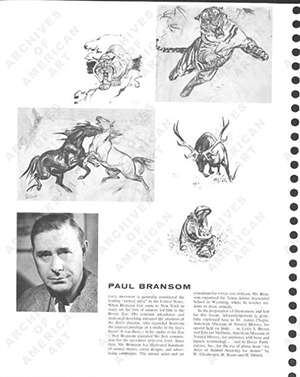 |
This lesson is designed to help you understand the basic principles behind the drawing of animals. It is not a collection of animal attitudes for copying, nor a condensed course on natural history. Its main purpose is to teach you to really "see" what you "look at" when you attempt to draw animals, to give you knowledge that will help you develop drawings that are both convincing and authoritative.
Learning to "see" is learning to draw. Because drawing is an analytical, informative process, you can learn to draw anything else. Animal drawing is a specialized form of art expression, yet there is nothing mysterious about it. It simply requires the same interest and effort you would have to put forth to qualify as a figure artists, architectural draftsman, or a painter of ships or airplanes.
True, some artists have an inherent attraction or feeling for certain subject matter, and become distinguished in a particular field. They seem to prove the old saying that "artists are born, not made," which only means that some are born with more interest and tenacity of purpose than others.
His President's message (no. 37) for the Society of Animal Artists 1965 exhibit: "The old saying 'Artists are born, not made' applies especially in the case of the true animal artist --with him (or her), picturing animals is not a decision-- it is a compulsion which is the dominant force of the artist's entire life and endeavor." |
To repeat, the purpose of this lesson is to help you "see" (understand) what you look at. Once this ability to "see" is gained, there will be no limit to how far you can go.
Many young people who want to become animal artists write that they live in the country or in a small city with no zoological park. There is no opportunity to study wild animals, they say. To have a fine zoological collection on hand is a great advantage, of course, especially to one who already has a sound working knowledge of how to draw animals. However, it is in no way necessary for the beginner. Almost everyone has access to a dog, a cat, a horse, cow, goat, rabbit, or mouse. This all you need, for they will furnish all the information required for a good start.
Nothing --absolutely nothing-- helps as much as drawing directly from "Life". Drawing and seeing are so interrelated that you simply cannot draw a thing and not learn something about how it is put together. Drawing is principally for information --your information-- and there is no surer way to impress information on your consciousness or memory than by drawing from life.. Even a poor sketch from life contains some elements of truth which cannot be obtained in any other way. Drawing constantly from life --with the "seeing eye"-- is the surest way to progress and success....
[Bransom gives a brief history of the representation of animals in art going back to Paleolithic paintings. He concludes this with a discussion of his immediate predeccessors and contemporiates:]
Real animal artists were scarce (possibly because of little demand) until Ernest Thompson Seton appeared with his charming animal stories and illustrations. These appealing and popular books sparked an explosion of nature stories, which hatched a brood of animal artists. Charles R. Knight, noted for his fine illustration murals and pre-historic restorations, was the dean of this group because he had perhaps the most thorough grounding in anatomy and art training.
Carl Rungius, a trained young German artist who came to the United States in 1894, quickly established himself as an illustrator of animal books. He developed into a masterful painter of American big game animals, and his landscape backgrounds were especially good. Charles Livingston Bull, Philip R. Goodwin, Gleeson, Bruce Horsfall and Lynn Bogue Hunt were also outstanding artists of this period when animal and bird stories were so popular.
Bull merits special attention. His pictures were composed with charming taste and striking design. They were purely subjective in treatment (he never literally rendered fur and feathers). His drawings always conveyed the feeling of mystery and grace one associates with animals, and he was able to capture the strange, fascinating environment of wild creatures. While his work was greatly influenced by Oriental art, it was securely based on sound knowledge of animals and birds.
At the beginning of this century, the magazines "Life" and "Judge" regularly published the drawings of T. S. Sullivant, noted as a caricaturist but really one of the great masters of pen technique. Sullivant drew animals with amazing knowledge of character and form....
Materials and Procedure:
Obtain a large sketchbook, or pad, made of paper with a slightly toothed, responsive surface --not too smooth, not too rough. A soft fibrous surface is better than a hard surface for charcoal, pencil, crayon and pastels.
You will need a large sketch pad because animals rarely hold a pose for long and you must endeavor to catch the salient points of whatever pose the animal assumes. Therefore, you will start several sketched on one page. The instant the animal shifts from the pose you are drawing, immediately abandon that sketch and start another. Soon you will have a dozen starts of different actions and attitudes on your paper, but you will also discover that the animal returns to one or all of these poses. In this way, you'll be able to add more factual lines and information to your sketches.
Don't try to make large, "pretty", finished drawings until you have acquired a good deal of experience. It is more important to get information, and doing these piecemeal sketches from life is positively the best method for acquiring the information. Animals, like men, are creatures of habit and have a regular routine each day. At approximately the same hour and place you'll find them doing the same things. They will be active at certain times of the day and resting at others. You can take real advantage of this fact if you are working from a zoo specimen, but barnyard animals and pasture stock also have routine habits. Once you become familiar with their schedule, you can arrange your plans accordingly.
You will find that drawing outdoors is uncomfortable and inconvenient, even under the best of conditions, so arm yourself with a stool. And get in the shade, if possible. Allowing the sun to shine steadily on your white paper is a handicap, and hard on the eyes.
You should always have a kneaded rubber eraser with you. The rubber is malleable in the fingers and is especially good with charcoal (remember that crayons are nonerasable). You can shape it to an edge or point for removing highlights.
Don't spend your time erasing and redrawing lines. Simply draw another line, or many lines, until the drawing is finished --no matter how rough.
After you have gained sufficient experience and ability in charcoal or pencil sketching, try your hand at soft pastels (they are perfect for catching transient color effects and lighting). Then move on to watercolors and oils for the color which is such an important element in the beauty and charm of animals. Do not let "color" run away with your interest, however. It is the frosting on the cake. You underlying drawing is the cake, and must be good to start with.
HERE IS A BRIEF SUMMARY OF HOW I GO ABOUT MAKING A PICTURE
First, I go through my many portfolios of life sketches, collected from years of practice at the zoo and elsewhere. I also visit the zoo, if possible, and make more sketches to refresh my memory of the characteristic points and psychology of the particular animal under consideration.
Next, I make several small composition sketches, relating the animals and their surrounding background --giving special attention to the harmonious arrangement of the shapes of the areas involved. Most beginners want to start a painting without any preliminary sketch, then quickly get into "picture" trouble and become discouraged. Some students will grudgingly consent to making one or two trial sketches, not realizing that any picture subject may be presented in a thousand different ways. For the most satisfying end results, don't go off "half cocked" without exploring at least some of the most interesting ways to tell your story effectively.
After selecting the composition best suited to my purpose, I enlarge the sketch to the required size by the simple, old method of dividing the sketch into squares and drawing an equal number of proportionately larger squares on a piece of paper the size the finished picture is to be.
The large drawing is carried as far as possible, completely finished in all details such as construction, foliage, rocks etc. All drawing problems are thought out and resolved in this charcoal, working drawing, including full tone values.
When the drawing is finished --but before "fixing" it-- I lay a sheet of heavy tracing paper over it and make it fast with masking tape. Then, with a smooth paper knife or burnisher, I rub an "offset" impression onto the tracing paper. When the offset image is heavy or strong enough, I place it face down on the canvas or illustration board and repeat the rubbing process. This gives me a faint but exact replica of my working drawing --where I want it-- so no redrawing is necessary on the canvas or board. Now I "fix" my working drawing so it will remain available for future reference while I am doing my finished picture. If you can improve on the drawing while painting, so much the better. But, if your brush should slip, or if you should lose some important feature, your working drawing becomes your insurance and guide.
This method is especially valuable for pastel pictures. Over the faint image you can direct "statements" with assurance, so essential for a crisp pastel technique. This same method can be used for pictures done in oil or watercolor. Just remember that watercolor is a transparent medium, so make your offset image as light and faint as possible.
Animals and Anatomy
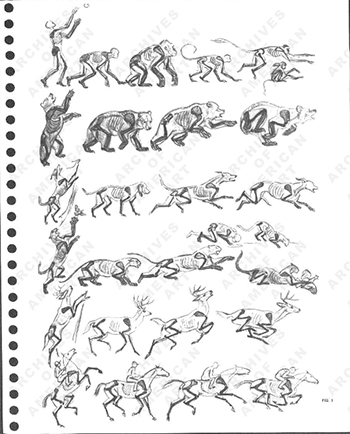 |
All animals (including man, for man is an animal) have the same basic construction and mechanical "hook up". This construction is built around the spine (backbone), a long string of small bones (vertebrae) fitted together with the skull at one end and the tail at the other. The spine and its skull are carried around by two articulated bridgeheads --the arms and legs in man, the front legs and rear legs in animals....
While all animals, birds, and reptiles are basically similar in construction, there are variations in size and shape of the same bones in different animals, as well as shapes of skull and toes. This is based on the need and environment of the individual animal, and does not alter the basic fact that all animals function on the same mechanical construction. You must keep this concept in your mind as you draw.
You will note on the drawings illustrating this lesson that the most important bones and bone edges are emphasized by heavy, black lines. These are the bones which are always evident on the outside of the animal and directly affect its appearance and movement....
These key bones and bone edges are of utmost importance, for they are your navigation stars or guides as you draw your way though the seemingly complicated sea shapes, curves and angles of all animal subjects, resting or moving.
As you draw, always think of the creature as a piece of construction built on its bony frame, rather than as an outline shape or flat silhouette. In fact, you should visualize your animal as you would visualize a barn or shed, with sills, studding, plates, and rafters. Just as the carpenter begins with his frame structure, you begin with a simple but definite bone frame structure for your animal. The principal muscles, details of expression, hide, color patterns, etc. all will follow in due course -- in in the right places!
It must be understood that this lesson will go into only such anatomy as is necessary to you as an artist. The drawings have been created to help you understand the principles of construction so you may "build" your animals in any pose you desire. The pose should depend on your knowledge, association and sensitivity to the habits and character of the type of animal your have chosen.
And practice makes perfect --much, much drawing from nature. Information gained from association and sympathy with animals is the indispensable ingredient for success....
Animal artists, of course, do not have to keep up-to-date on fashion design, yet they must become well-informed and familiar with all sorts of natural phenomena-- skies, water, trees, rocks, grasses, everything for the appropriate background-- but not just any landscape background. Each animal must be drawn in the right environment for his particular type....
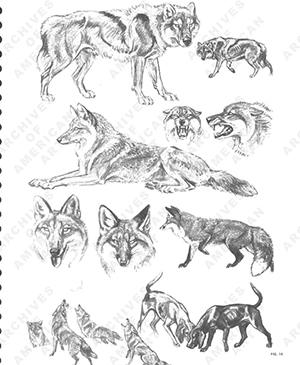 |
There is a strong resemblance among domestic and wild dogs, in spite of proportional variations in size of ears, length of nose, shape of eyes. However, we must consider the great difference in temperament. Through centuries of association with man, domestic dogs have developed a trusting benevolent attitude toward life. The wolf, coyote, fox and jackal, on the other hand, are hostile, crafty and suspicious because they have had to meet the harsh realities of a hostile world. The animal artist must express these differences through subtle exaggerations of certain features and attitudes....
The destination of the final version of this preparatory drawing is not known. It exemplifies Bransom’s interest in the psychology and not just the physical form of animals. Yes he knew the anatomy of the animals he drew, but he also studied their characteristic poses. He encouraged quick drawings from life and moving on to a separate drawing when the animal changes poses. From practice over time, an astute observer will be able to isolate characteristic stances of an animal. In these different stances the psychology of the animal emerges. The wariness of the two wolves is brought out by their guarded stances and their fixed attention on the potential threat posed by the intruding observer. |
Bransom brings out the contrast between the domestic dog and the wolf in an illustration from James Oliver Curwood's "Swift Lightning". Curwood describes the difference between Swift Lightning who is a mixed breed from the pure-bred wolves: "About him was little of the sneaking and cautious alertness of his brethern. He looked forth openly and unafraid. His back was straight, his hips free of the “wolf-droop,” and all over he was the soft and elusive gray of the gray brush-rabbit. His head had about it a massiveness that was strange to the wolf breed; his eyes were wider apart, his jowl heavier. And his tail did not not drag…." |
[Norman Kent in his "Paul Bransom: An Appreciation" (American Artist, April, 1947, p. 19) presents the following discussion by Paul Bransom about his philosophy and technique: "So many young artists think that if they can master the anatomy of a few animals, the rest will become easy. Nothing could be farther from the truth. Every animal has a movement and nature that are distinctive. The animal painter who wishes to represent living animals instead of stuffed ones must learn the habits of those he wishes to portray. He must gain, through actual experience either in the field or at the zoo, the intimate knowledge of his animals at various stages in their physical development, their eating and sleeping habits, and their reaction to man and other animals. Then on top of all this comes the very important job of composition --not only placing the animal in his natural habitat but relating him artistically to his background in such a way that the landscape will be as characterful as the animal. So, you see, in addition to being tremendously interested in animals, the successful painter of wild life must love the out of doors with an equal passion and learn to paint creditable landscapes. If he does not or will not go to this trouble, he will find himself in a position similar to the Shakespearean actor who spoke his lines with faultless diction but accompanied them with movements so awkward and labored that his audience audibly at the spectacle....
[p.23]: I try to make a quite finished drawing in charcoal, rather complete in detail and arrangement, in the process of which I use my fingers and a piece of kneaded rubber quite as much as the charcoal. When the drawing is finished as far as I can carry it, it is then 'fixed' with a fine spray of alcohol and shellac applied with an atomizer. They I work over and into the drawing with transparent washes of watercolor. However, when sketching from life, I confine my use of the charcoal to a spontaneous, significant line or smudge, put down as quickly and directly as possible-- trying to disregard unessential detail and concentrate upon the character and 'feel' of the subject. I believe there is a great unconscious force and simplicity to be cultivated in this way, and I also think that the very successful renderings achieved by the ancients, prehistoric cave drawings and primitive arts of all sorts, were due to this quality rather than to the self-conscious, arbitrary simplifications affected by many so-called 'modern' artists. A vital elemental drawing is the result of the association, it is emotional, instinctive rather than intellectual." (Archives of American Art, nos. 21-27)
Some Reflections on Animal Art and Artists (no.16):
During a long life engaged in the fascinating practice of drawing and painting animals, I have often been approached by young artists regarding the possiblity and the best way of becoming animal artists --because, "they like horses", or "dogs", or "because it appears to be an interesting field." I have conscientiously answered most of these queries to the best of my ability and tell them the truth, which may be distasteful. Unfortunately the simple truth is: Animals Artists are born, not made. Doing animals is a compulsion, it is not something you go into because it pays well, --as a rule it doesn't, though I must say a few animal artists have received fairly decent compensation in coin of the realm. The real compensation is the excitement and pleasure of the doing!
In the race for public appreciation and recognition, the efforts of four different types of artistic expression, viz., "Portraits", "Landscapes", "Still Life", and "Animals"; they finish in the order given with "Animals" a poor last place in favor and recompense. A survey of the history of animal artists will attest to this. For example, Barye, the great French animal sculptor, received scant appreciation or reward during his lifetime of hard work. Of course, I don't know how the Assyrian lion sculptors fared but I suspect, "the King" said, "make this and make that," and they did it! Probably the same deal with the Egyptian artists, the cavemen artists were probably priests and respected, but I have a well founded suspicion that their efforsts, which are today lauded with extravagant praise by "art critics" were these same pictures on canvas or drawn on paper by some fellow named "Bill Whosis" and shown in an exhibition of animal artists, they would receive scant notice.
To me, these are familiar thoughts but are again prodded into expression by an examination of the catalogue of the current exhibition at the Brooklyn Museum of Art --entitled "A Century of American Illustration" -- perhaps you've guessed it -- 120 pictures exhibited, not one well known animal artist represented, completely ignored-- entirely forgotten! That makes the record perfect for appreciation of animal artists, by "critics and curators."
Sadly and Sincerely,
Paul Bransom.
He has done more than many conservation measures to protect animals, for he makes us understand and love them, and what we love we do not destroy.That is the greatness of Paul Bransom; he makes us forget his art and remember the animals he draws. And that we do must please him, for he loves animals as most others love only man. --Dorothy P. Lathrop, "Paul Bransom," The Horn Book, May-June, 1940, p. 196. |
